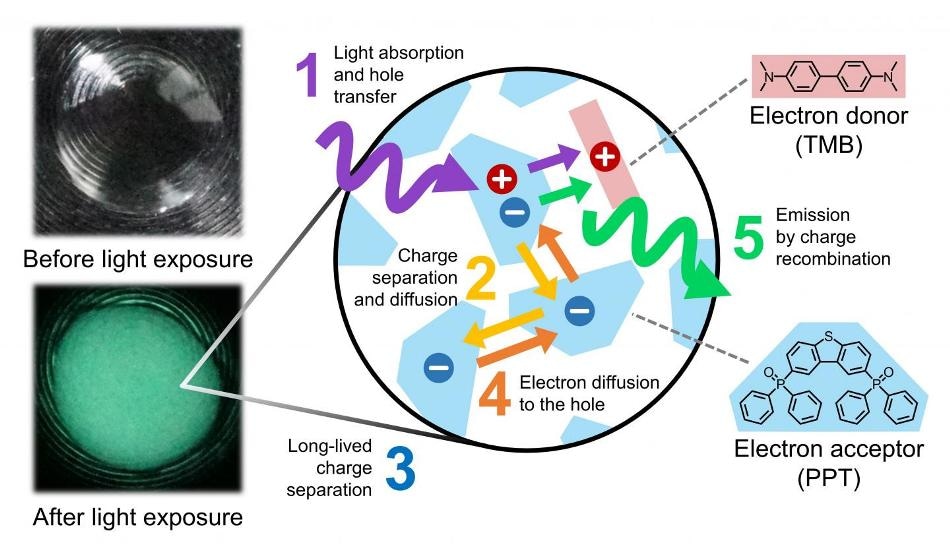Oct 3 2017
Glow-in-the-dark paints that have enhanced transparency and flexibility while also being easier and cheaper to manufacture are on the horizon courtesy of new research from Kyushu University. In an innovative demonstration, light emission lasting for more than one hour was obtained from organic materials, which are also considered to be promising for unlocking new applications such as in bio-imaging.
 CREDIT: Ryota Kabe and William J. Potscavage Jr.
CREDIT: Ryota Kabe and William J. Potscavage Jr.
Based on a process known as persistent luminescence, glow-in-the-dark materials work by slowly discharging energy absorbed from ambient light. Used in emergency signs and watches, commercial glow-in-the-dark materials are based on inorganic compounds and comprise of rare metals such as dysprosium and europium. However, these materials are expensive, need high temperatures to manufacture, and scatter light - as opposed to being transparent - when ground into powders for paints.
Carbon-based organic materials, similar to those used in pigments and plastics, are capable of overcoming many of these disadvantages. They can be exceptional emitters and are already extensively used in organic light-emitting diodes (OLEDs). However, achieving long-lived emission has been difficult, and the longest emission from organics under indoor lighting at room temperature was only a few minutes until now.
Researchers at Kyushu University's Center for Organic Photonics and Electronics Research (OPERA) have presently broken through this limit by using simple mixtures of two suitable molecules. In films developed by melting together molecules that donate electrons and ones that are capable of accepting electrons, emission lasting for more than an hour was demonstrated for the first time from organic materials without the requirement for low temperatures or intense light sources.
Many organic materials can use energy absorbed from light to emit light of a different color, but this emission is generally fast because the energy is stored directly on the molecule that produces the emission. By contrast, our mixtures store the energy in electrical charges separated over a longer distance. This additional step allows us to greatly slow down the release of the energy as light, thereby achieving the glow-in-the-dark effect.
Ryota Kabe, Lead Author on the paper
In the mixtures, absorption of light by an acceptor, or electron-accepting molecule, gives the molecule additional energy that it can use for removing an electron from a donor, or an electron-donating molecule. This transfer of an electron is efficiently the same as a positive charge being shifted from the acceptor to the donor.
It is then possible for the extra electron on the acceptor to hop to other acceptors and move away from the positively charged donor, leading to separation of the charges. The separated charges slowly come back together - some more quickly and some slowly - and discharge their energy as light over the span of nearly one hour.
The processes and mixtures are similar to what are found in OLEDs and organic solar cells. After building up separated charges like in a solar cell, the charges cannot escape anywhere, hence they eventually comeback together in order to release light like an OLED. The main difference in the newly developed mixtures refers to the fact that the charges can occur in a separated state for extremely long time periods.
With organics, we have a great opportunity to reduce the cost of glow-in-the-dark materials, so the first place we expect to see an impact is large-area applications, such as glowing corridors or roadways for added safety. After that, we can start thinking about exploiting the versatility of organic materials to develop glow-in-the-dark fabrics and windows, or even bio-compatible probes for medical imaging.
Chihaya Adachi, Director, OPERA
The first challenge to handle on the road to practical use refers to the sensitivity of the process to water and oxygen. Protective barriers are already employed in inorganic glow-in-the-dark materials and organic electronics, so the Researchers are thus confident that a solution can be discovered. Simultaneously, they are also focusing on new molecular structures in order to increase the efficiency and emission duration and also to change the color.
Efforts for solving these remaining issues are underway, and a new wave of glow-in-the-dark materials based on organics look composed to revitalize the area and increase their applications.